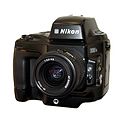 | |
| Overview | |
|---|---|
| Maker | Nikon |
| Type | Digital single lens reflex camera |
| Lens | |
| Lens | Interchangeable, Nikon F mount |
| Sensor/medium | |
| Sensor | 2/3 inch CCD VT (vacant Transfer) type with reduction optical system |
| Maximum resolution | 1.3 million pixels (1,280 X 1,000 array) [1] |
| Film speed | ISO equivalency 800, 1600 and 3200 |
| Storage media | PCMCIA Image Memory Card EC-15 |
| Focusing | |
| Focus modes | Single-Servo Autofocus mode, Continuous-Servo Autofocus mode, Manual |
| Focus areas | TTL phase detection system using Nikon Advanced AM200 autofocus module |
| Focus bracketing | n/a |
| Exposure/metering | |
| Exposure modes | Program (P), Shutter-Priority AE (S), Aperture-Priority AE (A) and Manual (M) |
| Exposure metering | Matrix Metering: EV 1 to 16-1/3, Center-Weighted Metering (70% centre): EV 1 to 20, Spot Metering: EV 2 to 20 |
| Flash | |
| Flash | Speedlights supported, Standard TTL Flash possible |
| Flash bracketing | n/a |
| Shutter | |
| Shutter speed range | 1/2 sec. to 1/2000 |
| Continuous shooting | E3: 1 frame/s E3s: 3 frame/s up to 12 images |
| Viewfinder | |
| Viewfinder | Optical type fixed eye level pentaprism Approx. 98% frame coverage, Approx. 0.7x magnification |
| Image processing | |
| White balance | Auto, Incandescent light (3,000k), Fluorescent light (6,700/5,000/4,200K), Fine weather (5,300K), Cloudy weadher (6,500K), Shade (8,000K), and Flash mode (5,700K). |
| WB bracketing | Shoot 2 to 3 frames, each at a different exposure. Compensation value range of steps from ±1/4 to ±3/4. Select among 9 combinations. |
| General | |
| LCD screen | None |
| Battery | Ni-MH Battery Pack EN-3 |
| Weight | approx. 1,850g |
| Made in | |
The Nikon E series, co-developed with Fujifilm, [2] are autofocus 1.3 megapixel professional grade quasi-full frame (35mm) Nikon F-mount digital single lens reflex cameras (DSLR) manufactured by Nikon since 1995.
Contents
- Technology
- Optical system
- Storage and replay
- Variants
- History
- Nikon E2/E2S
- Nikon E2N/E2NS
- Nikon E3/E3S
- See also
- References
The E series included the Nikon E2/E2S, Nikon E2N/E2NS and the Nikon E3/E3S. The S-variants are identical except they had triple the frame rate and a larger buffer.
Its unique optical system bundles the light of the full-frame lenses to the small 2/3 inch CCD sensor. That gives approximately 4 stops more light at the small sensor, therefore delivering an exceptional (for that time) minimum sensitivity of 800 and maximum 3200 ISO, which remains usable for press and news use. [2]



